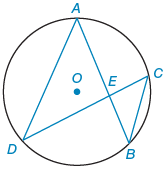
Alyssa Z.
asked • 04/16/21Given:AE = 7, EB = 4 DC = 16. Find:DE and EC (Assume DE > EC.)
Consider the following theorem.
If two chords intersect within a circle, then the product of the lengths of the segments (parts) of one chord is equal to the product of the lengths of the segments of the other chord.
O is the center of the circle.
 A circle contains six labeled points and four line segments.
A circle contains six labeled points and four line segments.
- The center of the circle is point O.
- Points A, B, C and D are on the circle. Point A is on the top middle, point B is on the bottom right, point C is slightly above the middle right, and point D is on the bottom left.
- A line segment connects points A and B.
- A line segment connects points C and D.
- A line segment connects points A and D.
- A line segment connects points C and B.
- Point E is the intersection of line segments A B and C D. Point E is to the right and slightly below point O.
| Given:AE = 7 |
| EB = 4 |
| DC = 16 |
| Find:DE and EC |
| (Assume DE > EC.) |
1 Expert Answer

Yefim S. answered • 04/16/21
Math Tutor with Experience
DE·EC = AE·EB = 7·4 = 28;
DE + EC = DC = 16; EC = 16 - DE
DE(16 - DE) = 28; DE2 - 16DE + 28 = 0 ; (DE - 2)(DE - 14) = 0; DE = 14 and EC = 2
Still looking for help? Get the right answer, fast.
Get a free answer to a quick problem.
Most questions answered within 4 hours.
OR
Choose an expert and meet online. No packages or subscriptions, pay only for the time you need.





Mark M.
What does the theorem state? Do you have difficulty with the English or with the Geometry?04/16/21